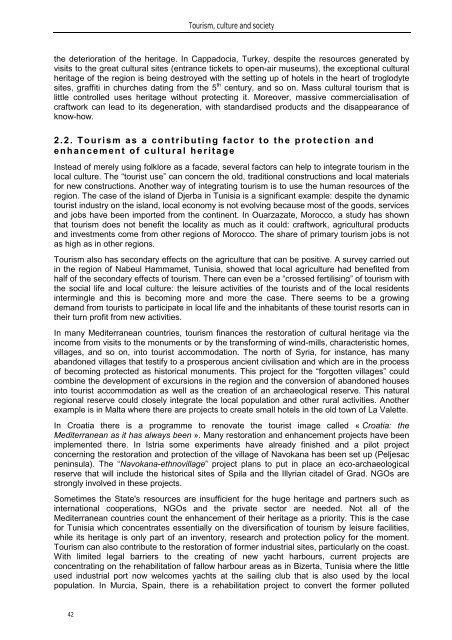dossier sur le tourisme et le développement durable
dossier sur le tourisme et le développement durable
dossier sur le tourisme et le développement durable
You also want an ePaper? Increase the reach of your titles
YUMPU automatically turns print PDFs into web optimized ePapers that Google loves.
42<br />
Tourism, culture and soci<strong>et</strong>y<br />
the d<strong>et</strong>erioration of the heritage. In Cappadocia, Turkey, despite the resources generated by<br />
visits to the great cultural sites (entrance tick<strong>et</strong>s to open-air museums), the exceptional cultural<br />
heritage of the region is being destroyed with the s<strong>et</strong>ting up of hotels in the heart of troglodyte<br />
sites, graffiti in churches dating from the 5 th century, and so on. Mass cultural tourism that is<br />
litt<strong>le</strong> control<strong>le</strong>d uses heritage without protecting it. Moreover, massive commercialisation of<br />
craftwork can <strong>le</strong>ad to its degeneration, with standardised products and the disappearance of<br />
know-how.<br />
2.2. Tourism as a contributing factor to the protection and<br />
enhancement of cultural heritage<br />
Instead of merely using folklore as a facade, several factors can help to integrate tourism in the<br />
local culture. The “tourist use” can concern the old, traditional constructions and local materials<br />
for new constructions. Another way of integrating tourism is to use the human resources of the<br />
region. The case of the island of Djerba in Tunisia is a significant examp<strong>le</strong>: despite the dynamic<br />
tourist industry on the island, local economy is not evolving because most of the goods, services<br />
and jobs have been imported from the continent. In Ouarzazate, Morocco, a study has shown<br />
that tourism does not benefit the locality as much as it could: craftwork, agricultural products<br />
and investments come from other regions of Morocco. The share of primary tourism jobs is not<br />
as high as in other regions.<br />
Tourism also has secondary effects on the agriculture that can be positive. A <strong>sur</strong>vey carried out<br />
in the region of Nabeul Hammam<strong>et</strong>, Tunisia, showed that local agriculture had benefited from<br />
half of the secondary effects of tourism. There can even be a “crossed fertilising” of tourism with<br />
the social life and local culture: the <strong>le</strong>i<strong>sur</strong>e activities of the tourists and of the local residents<br />
interming<strong>le</strong> and this is becoming more and more the case. There seems to be a growing<br />
demand from tourists to participate in local life and the inhabitants of these tourist resorts can in<br />
their turn profit from new activities.<br />
In many Mediterranean countries, tourism finances the restoration of cultural heritage via the<br />
income from visits to the monuments or by the transforming of wind-mills, characteristic homes,<br />
villages, and so on, into tourist accommodation. The north of Syria, for instance, has many<br />
abandoned villages that testify to a prosperous ancient civilisation and which are in the process<br />
of becoming protected as historical monuments. This project for the “forgotten villages” could<br />
combine the development of excursions in the region and the conversion of abandoned houses<br />
into tourist accommodation as well as the creation of an archaeological reserve. This natural<br />
regional reserve could closely integrate the local population and other rural activities. Another<br />
examp<strong>le</strong> is in Malta where there are projects to create small hotels in the old town of La Va<strong>le</strong>tte.<br />
In Croatia there is a programme to renovate the tourist image cal<strong>le</strong>d « Croatia: the<br />
Mediterranean as it has always been ». Many restoration and enhancement projects have been<br />
imp<strong>le</strong>mented there. In Istria some experiments have already finished and a pilot project<br />
concerning the restoration and protection of the village of Navokana has been s<strong>et</strong> up (Peljesac<br />
peninsula). The “Navokana-<strong>et</strong>hnovillage” project plans to put in place an eco-archaeological<br />
reserve that will include the historical sites of Spila and the Illyrian citadel of Grad. NGOs are<br />
strongly involved in these projects.<br />
Som<strong>et</strong>imes the State's resources are insufficient for the huge heritage and partners such as<br />
international cooperations, NGOs and the private sector are needed. Not all of the<br />
Mediterranean countries count the enhancement of their heritage as a priority. This is the case<br />
for Tunisia which concentrates essentially on the diversification of tourism by <strong>le</strong>i<strong>sur</strong>e facilities,<br />
whi<strong>le</strong> its heritage is only part of an inventory, research and protection policy for the moment.<br />
Tourism can also contribute to the restoration of former industrial sites, particularly on the coast.<br />
With limited <strong>le</strong>gal barriers to the creating of new yacht harbours, current projects are<br />
concentrating on the rehabilitation of fallow harbour areas as in Bizerta, Tunisia where the litt<strong>le</strong><br />
used industrial port now welcomes yachts at the sailing club that is also used by the local<br />
population. In Murcia, Spain, there is a rehabilitation project to convert the former polluted
















